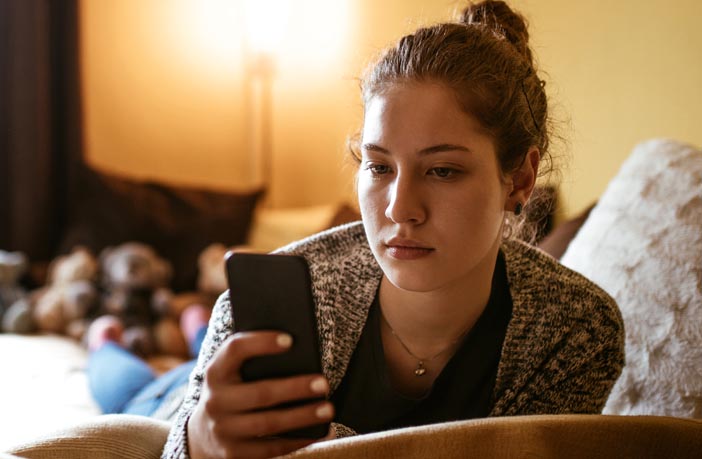
Can how you feel about your body relate to how you look at social media posts? A study published in Computers in Human Behavior tracked women’s eye movements while viewing Instagram posts to determine how their viewing behavior relates to their body image.
Social media is a nearly inescapable piece of everyday life for most people. While social media can foster connection and communication, with widened popularity, there is increased risk of being exposed to harmful ideas or images. One particularly common negative outcome of social media usage is social comparison of oneself to idealized body types leading to negative self-image and lowered self-esteem.
This phenomenon is especially prevalent when using Instagram, a social media site focused specifically on images. Eye tracking is a useful tool for such situations and can help determine how people are interacting with images, including suggesting if they are using top-down or bottom-up processing. This study sought to understand what people’s eyes fixate on in images and how that relates to body image.
For their study, Graham G. Scott and his colleagues utilized 60 people who identified as women recruited from a university to serve as their sample. 93% of participants had Instagram and the 7% that did not have it reported being familiar with the site. Participants were shown images of either face only or body only of females who were underweight, average, or overweight.
Participants viewed a 3 x 4 photo array made to look like Instagram’s layout on a mobile phone. The array contained 2 pictures of each condition. Participants rated their own body satisfaction. Their eye movements while viewing the photo array were recorded using an eye-tracker.
The results indicated an attentional bias for underweight bodies and average faces. This meant that participants looked at average faces and underweight bodies for longer and were more likely to fixate on those images. These results are consistent with current beauty standards that favor skinny bodies and average faces.
Images of bodies were viewed more often and for longer than images of faces. This might be because bodies offer more cues about someone’s weight than faces do, so these images could be more informative for users who compare themselves to others.
Interestingly, the study found that a person’s own feelings about their body can influence what images they look at and how long they look at them. Those who were less satisfied with their own bodies tended to avoid looking at images of underweight bodies and faces.
Results showed support for the idea that image content drove bottom-up processing and personal attitudes influenced top-down processing. Bottom-up processing involves starting with the basic information or data and then building up to a full understanding or perception. It’s driven by the raw data we receive from our senses. On the other hand, top-down processing involves using our existing knowledge and expectations to interpret new information.
For bottom-up processing, the visual characteristics of the images (e.g., body shape and part of the body depicted) had an impact on how long and how often participants looked at them. So, the raw, sensory data (the images) were driving the participants’ behaviors.
On the other hand, for top-down processing, participants’ self-perceptions affected where they looked and how often. For example, if a participant was not satisfied with her own body, she might have looked less frequently at images of underweight women, perhaps due to increased anxiety or discomfort.
This study took interesting and significant steps into better understand how women look at social media images. Despite this, there are limitations to note. One such limitation is that participants were only women and were only shown images of women. Future research could expand and provide gender diversity in sample and stimuli. Additionally, this study utilized images that had no text accompanying them, and previous research suggests that text or comments with images could have a mediating effect.
“In conclusion, by measuring the eye movements of female Instagram users while they viewed stimulus arrays containing images of under-, average-, and over-weight female bodies and faces, we found differential effects of bottom-up and top-down factors. These manifested differently in ‘where’ and ‘when’ measures of eye movement behaviour,” the researchers wrote.
“The bottom-up factors such as Body Part and Body Shape particularly drove the ‘when’ measures of eye movement, whereas participants’ body satisfaction influenced ‘where’ measures in a top-down fashion. Participants selectively attended to bodies over faces and overall preferred Underweight and Average images to Overweight ones. Participants avoided looking at images which reflected their own areas of lower body satisfaction.”
“These results provide insight into the mechanisms of a potentially dangerous cycle promoted by social media platforms; exposure to damaging images leads to upwards social comparison and as a result personal satisfaction in users. This in turn could promotes a perceptual bias to selectively attend to more-damaging stimuli.”
The study, ““Thinstagram”: Image content and observer body satisfaction influence the when and where of eye movements during instagram image viewing“, was authored by Graham G. Scott, Zuzana Pinkosova, Eva Jardine, and Christopher J. Hand.
"behavior" - Google News
July 26, 2023 at 04:41AM
https://ift.tt/ijDORmN
Eye-tracking study finds link between women's visual behavior on Instagram and body image - PsyPost
"behavior" - Google News
https://ift.tt/UuQJm6e
Bagikan Berita Ini














0 Response to "Eye-tracking study finds link between women's visual behavior on Instagram and body image - PsyPost"
Post a Comment